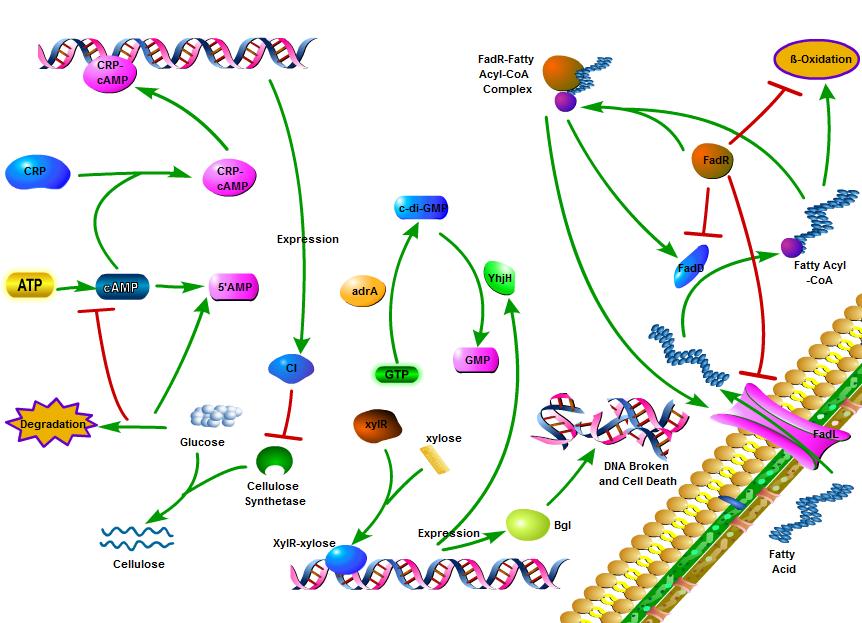|
The utmost purpose of our project is to emancipate people from suffer of obesity and the restriction of diet. It can be achieved by genetically modifying a resident intestinal microbe, such as E.coli, to create a novel beneficial bacterial which is competent to eliminate the excessive absorption of calorie.
Fatty acids are our primary targets. The competition between the absorption of the intestine and of the microbe on the surface of intestine is considered as a solution. To prevent the over in-take and accumulation of fatty acids, we will try to engineered microbe that can metabolize the excessive fatty acids in diet efficiently and effectively before they are absorbed by the host. To achieve this, we will overexpress the enzymes responsible for fatty acids degradation under the control of a natural sensor for concentration of fatty acids-- FadR, a repressor for the genes involving in fatty acids degradation. The problem is that we cannot use it directly since the natural promoter it regulates is also under the regulation of other factors responding to other signals. A synthetic promoter is then proposed to tackle the problem. A constitutive promoter is fused to the original binding site of FadR. If such promoter is added in front of the target genes, they can only express when the FadR senses the high concentration of fatty acids and slides off the site on DNA. The gene expression will and will solely respond to high concentration of fatty acids.
Also, since the glucose can be transformed into fatty acids in our body, we will try to transform the glucose into polymers, such as cellulose, which cannot further be degraded and absorbed by the host. Instead of contributing to the formation of fatty acids, the glucose is turned into a healthier substance. The polymers made from the glucose may facilitate the growth of other species which have been proved to be beneficial for maintaining a normal weight. Enzymes responsible for cellulose synthesis are accessible from other species of bacteria and can be implanted into E.coli. To sense the glucose concentration and respond exclusively to it, we choose CRP as regulator. Specifically, we will change this activator into a repressor by overlapping its binding site downstream the constitutive promoter instead of in front of it. Then the relative gene can only be activated when the CRP cannot bind the site on DNA in high glucose concentration. This synthetic promoter may have broad applications. For example, it can be used in gene therapy for diabetes.
Another problem we will try to tackle is the survival and the colonization of the bacterial in intestine. One commonly accepted theory is that a species introduced into a new place gets the chance of surviving and even being dominant if it can utilize an energy resource that cannot be used by any other species. According to the theory, the unmatchable ability of the E.coli to utilize the fatty acids as its carbon sources can already partially fulfill the goal. The adhesion to intestinal cells is another factor for its survival other than the energy requirement. We will try to increase the adhesion ability of the E.coli by enhancing its production of c-di-GMP, a second massager which has been reported to increase adhesion of bacteria.
Biological safety should be paid equal attention in the progress of designing novel probiotic. To prevent the uncontrolled reproduction of the modified E.coli in the intestine, we have designed a death system to wipe out the GMOs at will. It also exploits the natural sensor for the signal molecule xylose to regulate its target, which is the endonuclease responsible for kill the cell quietly without setting off immunological reaction. Also, Horizontal gene transfer will also trigger the death of the recipient.
To sum up , we not only propose a novel and interesting way to tackle the obese problems but also create the biological sensors for fatty acids and glucose which have broad application in detection and therapy of related diseases .
|Fig.The overall design of our system.
|
|
 "
"


